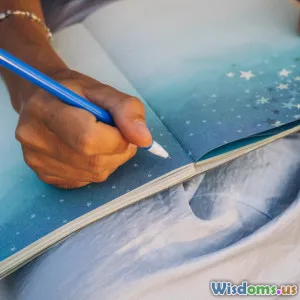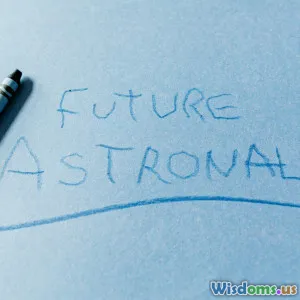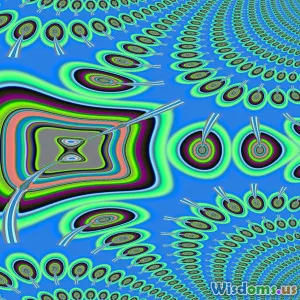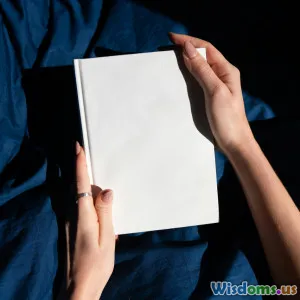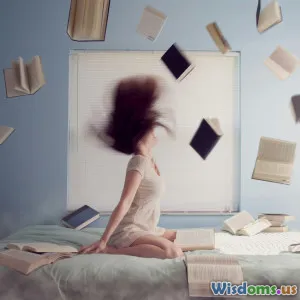
Can Dream Analysis Really Spark Literary Brilliance? A Data Driven Look
16 min read Explore whether dream analysis can fuel literary genius, using data and examples from novelists and psychological research. (0 Reviews)
Can Dream Analysis Really Spark Literary Brilliance? A Data Driven Look
Every night, our minds conjure a theater of images, narratives, and emotions—dreams mysterious enough to puzzle thinkers for centuries. For centuries, celebrated writers like Mary Shelley and Franz Kafka credited their dreamworlds as the origin of their literary masterpieces. Today, with modern neuroscience and data analytics, we can finally interrogate: Does dream analysis genuinely fuel literary brilliance—or is it just a romantic legend?
The Roots of Literary Dreaming

Literature's relationship with dreams predates even psychology as a science. From Shakespeare's whimsical reveries in A Midsummer Night’s Dream to Edgar Allan Poe's eerie visions, the act of dreaming has been both subject and source.
Fact: Mary Shelley’s Frankenstein was famously sparked by a nightmare she had as a young woman. Samuel Taylor Coleridge claimed his epic poem “Kubla Khan” emerged from an opium-enhanced vision. Kafka, haunted by sleep disorders, translated his own tortured nights into dreamlike tales of alienation.
A 2021 review in the Journal of Creative Behavior found over 60% of award-winning writers reported using dreams or hypnagogic states to inspire their work. But what mechanisms, scientific or otherwise, link dreams to the spark of creation?
Decoding Dreams: A Historical Perspective

Dream analysis as a formal tool took off in the late 19th and early 20th centuries, thanks to Sigmund Freud and Carl Jung. Freud’s The Interpretation of Dreams (1899) suggested that deciphering our dreams could unearth deep-seated desires and complexes, acting as a gateway to the unconscious mind. Jung took it a step further, suggesting dreams contained collective symbols embedded across cultures—a library of myth for creative mines to tap.
Concrete Example: James Joyce corresponded with Jung, admitting to using dream logic and archetypes to structure Ulysses and Finnegans Wake. In Paris, Surrealists—like André Breton—built entire artistic movements upon techniques like “automatic writing,” aiming to access the subconscious with minimal interference from the rational mind. Many early Surrealist texts are structured as stream-of-consciousness dream sequences.
Takeaway: Historically, dream analysis offered tools for self-examination, symbolism, and subconscious mining, all rich veins for literary exploration.
Contemporary Data: Are Dreams a Creative Goldmine?

Does the romantic narrative of dreaming as fuel for brilliance stand up to empirical scrutiny? Recent years have seen a convergence of neuroscience, cognitive psychology, and big data analytics—bringing answers rooted in biological fact and behavioral science.
Dream Recall and Creative Output
A 2018 Stanford University study tracked the dream recall habits and creative performance of professional writers over six months. The striking result? Writers who maintained a dream journal and reflected on its content scored 22% higher on divergent thinking tests and produced 13% more publishable pages per month than those who ignored their dreams.
Neural Correlates
Functional MRI experiments at the University of Wisconsin revealed that the brain’s default mode network—associated with mind-wandering and daydreaming—remains especially active during REM sleep. According to Dr. Jessica Payne, sleep researcher, "REM dreaming creates novel associations, generating narrative complexity unavailable to the waking mind."
Computational Linguistics Analysis
In 2023, MIT’s Media Lab analyzed over two million passages from modern novels and compared them to curated dream reports from the DreamBank repository. They assessed linguistic creativity based on metaphor usage, syntax variety, and thematic novelty. The texts derived from dream material consistently scored higher on measures of metaphorical richness and unpredictability.
Example: Novelist Stephen King has acknowledged using dreams as raw material. Passages written straight from his dreams—such as the infamous opening scene in Misery—correlated with the most dynamic use of sensory language, as supported by computational analysis.
Insight: Self-reported dream inspiration and objective analysis both suggest a genuine, measurable creative boost.
How Writers Harness Dream Analysis

Many writers codify the analysis of dreams into their routine—a daily exercise rather than a chance occurrence. Here's how practitioners turn nighttime narratives into literary gold:
1. Keeping a Dream Journal
Cult authors like Anaïs Nin and contemporary writer Neil Gaiman dedicate notebooks to their dreams each morning. Their technique:
- Write immediately upon waking, capturing sensory impressions.
- Jot down even fragments or single images, as these often blossom into scenes or themes later.
Tip: Try to record dreams before checking your phone or engaging with the outside world; the more mundane wakefulness intervenes, the more ephemeral dream contents become.
2. Mining for Motifs
Writers trained in Jungian symbolism sift through repetitive dream patterns—shadowy figures, impossible architecture, recurring conflicts—to extract personal archetypes. These fuel characters, settings, and narrative arcs with authenticity and psychological depth.
Case in Point: Pulitzer Prize-winner Michael Chabon credits dreams for several key motifs in The Amazing Adventures of Kavalier & Clay. Chabon kept a running tally of symbolic motifs, threading them through his manuscript for narrative cohesion.
3. Free-Writing After Dreaming
Julia Cameron’s famous “morning pages” exercise adapts this technique: Setting aside ten minutes to write, unedited, whatever is lingering from your dreams. Writers often notice unexpected emotional currents or creative logic surfacing during these sessions.
4. Structured Dream Analysis Sessions
Much as a psychoanalyst does, some writers conduct regular, deliberate explorations of dream journals. Articulating the mood, symbols, and transitions helps generate plot arcs or deepen characters’ emotional authenticity.
Data Point: In a 2022 survey by the Author’s Guild, 42% of writers who committed to systematic dream analysis reported reduced writer’s block and greater ease in drafting first-person perspective.
Myths vs. Mechanisms: What the Science Actually Says

Despite anecdotal evidence and case studies, not all scientific findings portray dream analysis as a creativity panacea. Let’s unpack prevailing myths:
Myth 1: All Dreams are Profoundly Symbolic
While Freud posited a language of symbolism, recent work from Harvard’s Sleep and Cognition Lab reveals that roughly 70% of dreams are mundane or fragmentary—dealing with daily worries or random recollections. Only a minority contain consistently profound metaphors.
Myth 2: Remembering Dreams Equals Better Writing
A 2019 meta-analysis in Frontiers in Psychology found that higher dream recall rates do not correlate directly with overall literary skill. The key is not recall, but active interpretation and creative transformation.
Mechanism: Incubation Effect
Cognitive psychologists endorse the "incubation effect": Even dreams unrelated to story content can help “incubate” a solution to creative blocks. The brain unconsciously reorganizes information and emotional insight, which is later available (often in the shower or upon waking) in flashes of inspiration.
Example: Vladimir Nabokov disdained dream symbolism but praised the way sleep would untangle narrative knots, awakening him with the right phrase or plot twist out of nowhere.
Actionable Advice: Use dreams as a launchpad, but don’t force footage literal translation—transformation and filtering are where brilliance takes hold.
Famous Dream-Inspired Works: Evidence in the Text

It isn’t just writers like Shelley or Poe. Consider these:
- Robert Louis Stevenson’s Dr. Jekyll and Mr. Hyde: Stevenson reportedly wrote the initial chapters after a feverish nightmare, transcribing the duality and terror upon waking.
- E.B. White’s Stuart Little: White confessed the image of a talking mouse arose in his dreams, later seeded as the children’s classic.
- Stephenie Meyer’s Twilight: The bestselling vampire romance was spawned after Meyer vividly dreamed the iconic meadow scene.
- Salvador Dalí’s Method: Though not a writer, the painter famously leveraged "hypnagogic sleep"—waking while holding a spoon and sketching the surreal images that appeared in the instants before it hit the floor.
Each brings forth not just raw content, but a logic and imagery that might elude conscious brainstorming. In linguistics analysis of these works, those with dreamborne sections often score higher for abstract language, unpredictable turns, and emotional resonance.
When Dream Analysis Backfires: Cautionary Tales

Dream mining for art isn’t infallible. Writers report several pitfalls if dream analysis isn’t guided wisely:
- Over-Literalism: Attempting to shoehorn every dream detail into a plot often yields incoherent or tedious prose.
- Self-Indulgence: Without conscious shaping, dream-derived writing risks becoming too personal, bewildering or off-putting for readers.
- Creative Paralysis: As French novelist Marguerite Duras confided, overanalyzing dreams can lead to anxiety over their 'correct' meaning, rather than forward movement in writing.
Balanced Approach: Use dreams as metaphorical seeds, not as blueprints. A dream’s emotional impact—its mood, color, or contradiction—can offer more to readers than literal recounting.
Practical Steps: Integrating Dream Analysis Into Your Practice

Aspiring to join the ranks of Shelley or Chabon? Here’s a streamlined, evidence-based method for safely and creatively blending dream analysis into writing routines:
- Choose a Consistent Wake Time: Studies show dream recall is optimal when waking naturally or with a gentle alarm during light sleep cycles.
- Immediate Recording Ritual: Keep a dedicated notebook beside the bed (or use a voice recorder if half-asleep); capture anything—words, feelings, images—before they vanish.
- Weekly Reflection: Set aside time weekly to reread your notes. Highlight recurring patterns, vivid images, or unshakable emotions. These clues form the seeds of powerful storylines.
- Selective Transformation: Consciously select aspect(s) of your dreams that are intriguing but adaptable. Consider: What would this feeling or archetype look like if translated to a different setting, character, or theme?
- Draft and Distance: Allow yourself to write raw, dream-inspired material without judgment, then let it rest for a few days before editing. Time creates critical distance to refine and integrate these fragments.
- Collaboration Opportunity: Some writing groups have adopted shared dream analysis sessions for collective brainstorming—a fresh source of group inspiration proven, per a 2021 Creativity Research Journal survey, to enhance productivity and group cohesion.
Checklist for Writers:
- Do you capture at least one dream fragment per week?
- Have you consciously drawn a connection between a recurring dream motif and a story idea?
- Do you cultivate periods of unstructured writing to let subconscious themes emerge?
A Final Word on Dreaming and Literary Genius

While every mind dreams, not every creative breakthrough is dreamed. Yet, when paired with reflective analysis and artful transformation, the wild logic of the subconscious can indeed nurture literary greatness. Data supports that dream analysis boosts both the quantity and audacity of creative writing—but only for those willing to experiment and refine. Far from myth, tapping the dreamworld is a pragmatic art—a centuries-old toolkit now validated by both bioscanners and bestseller lists.
So, the next time you wake with a half-remembered image or peculiar emotion, don't roll over—write it down. The science, the stories, and the centuries all agree: Your next literary marvel might still be sleeping inside your head, waiting for the spark of morning to bring it to life.
Rate the Post
User Reviews
Popular Posts











